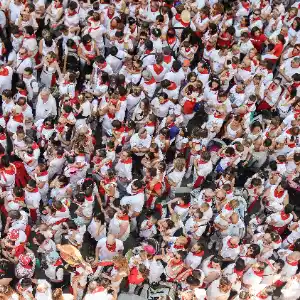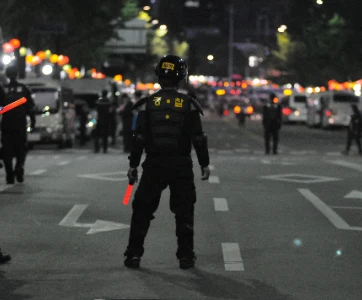The Seoul crowd crush - From a psychological perspective
Updated on 13th November, 2022
On October
29th, 2022, more than 150 people died, and dozens were injured in the Seoul, South Korea, "crowd crush," which is a surge of people that results from crowds being packed in a confined space. Injury and death can result as
the movement of masses of people occurs, such as people pushing one another. This creates a chain reaction, causing the crowd to fall, similar to a "domino effect." The tragedy occurred as approximately 100,000 people gathered to
celebrate Halloween in Itaewon, a popular nightlife district in Seoul.
Crowd crushes are highly dangerous but also completely preventable. When largegroups of people, like the one in Itaewon last Saturday, are effectively
managed by police or firefighters, crowd surges can be entirely avoided.

How is panic involved in a crowd surge?
While you might think that crowd surges are a result of people panicking, which then leads to pushing and shoving, it is the opposite scenario that actually occurs. Once the crowd begins to collapse — which essentially means that
people are falling on top of each other — distress and panic ensue as everyone struggles to get up. In other words, a crowd surge happens because of poor crowd control strategies that should be implemented and enforced by city or
government officials. The surge is almost inevitable when a large group of people is packed into a small or narrow space. Panic occurs once the crowd begins to fall, people get injured, and they begin to realize that their lives
are in danger.
So, although panic does not start a crowd surge, it still plays a significant role in the death toll of these types of tragedies. Plus, a collective sense of panic occurs as onlookers begin to realize what is occurring close by.
For instance, once people realize that there are casualties and serious injuries, their natural reaction is to want to escape the crowd and get somewhere safe. This can then lead to mass panic and potentially trigger additional
crowd surges as people try to push and shove their way out.

How mimicking the crowd plays a role in panic-ridden situations?
When people are afraid or are faced with a significant threat, their ability to problem-solve and make decisions for themselves could often be impaired. Not everyone can think straight in moments of chaos, particularly when there is
an imminent risk to life. This leads to a loss of individual identity and a greater likelihood of following the crowd. This circumstance can lead to collective crowd psychology, whereby people may copy the behaviors of others. The
Chameleon Effect or the Mob Mentality are examples of the human tendency to neglect their individual identity — and ability to make decisions for themselves — and instead mimic a group. This means that if you see the person next to you
and in front of you running, pushing, and shoving, it's likely that you may do the same if you're in a situation where you feel afraid or threatened.
The idea is that thinking for yourself and acting in a way that is
different from those around you might seem dangerous or too risky to you. You may doubt your decision-making and your own ability to keep yourself safe, so you err on the side of caution and copy what you see others doing. The
reality is that the crowd could very likely be making the wrong decision, moving in an unsafe direction, or otherwise leading you into a more dangerous circumstance. In crowd crushes, people can become so consumed with mimicking the
crowd that they can miss obvious opportunities to seek safety, such as the presence of accessible exits.

Here's the issue with crowd behavior in situations like an impending crowd surge:
The crowd forms a series of interconnected behavioral "cells," and each cell is made up of a small group of people. The problem is that there is little, and sometimes no communication from cell to cell, so the people within one cell
don't really know what's going on among the rest of the crowd. In a crowd surge situation, if the people within one cell did know what was going on in other cells, they would remain calm and avoid pushing, shoving, or trying to
escape.
Also present within a cell is what is known as a "dominant cell member," which is a person who influences the behaviors of everyone in the cell or, put differently, everyone in the cell copies this dominant cell member's behavior.
If the behavior of this person is erratic or unsafe, it can put the whole cell and surrounding cells in danger. There can be some communication from cell to cell, but in a moment of panic and chaos, there is a greater likelihood of a
lot of misinformation, which can trigger panic-like behaviors. This process might seem like quite a complex series of events, but it can occur within minutes or even seconds as a crowd surge builds and ultimately takes place.
Applying problem-solving skills and good decision-making during moments of high stress
So, what can you do if you find yourself in the midst of a crowd crush? Experts say
that there really isn't much you can do if the surge has begun. This is because of the sheer strength and pressure that results from it. However, if you find yourself within a large crowd that seems to be becoming more densely
packed, calmly make your way out of the center of the crowd. Look out for exits when you're in a crowded outdoor area or indoor setting, and make a mental note of how you will get out should an emergency occur. It's not about being
paranoid, but vigilant and smart. By having a plan in place, you can safely enjoy yourself when gathering in large groups.
Ultimately, however, it's likely best to avoid events and activities where crowds could potentially get
out of control. Ask yourself if there is something else you would enjoy doing instead that doesn't involve being jam-packed into a tight space with a bunch of sweaty strangers breathing in your face. Many people opt to skip these types
of heavily crowded events and meet up with friends afterward. This way, you can still enjoy yourself and be social without entering a potentially dangerous situation.